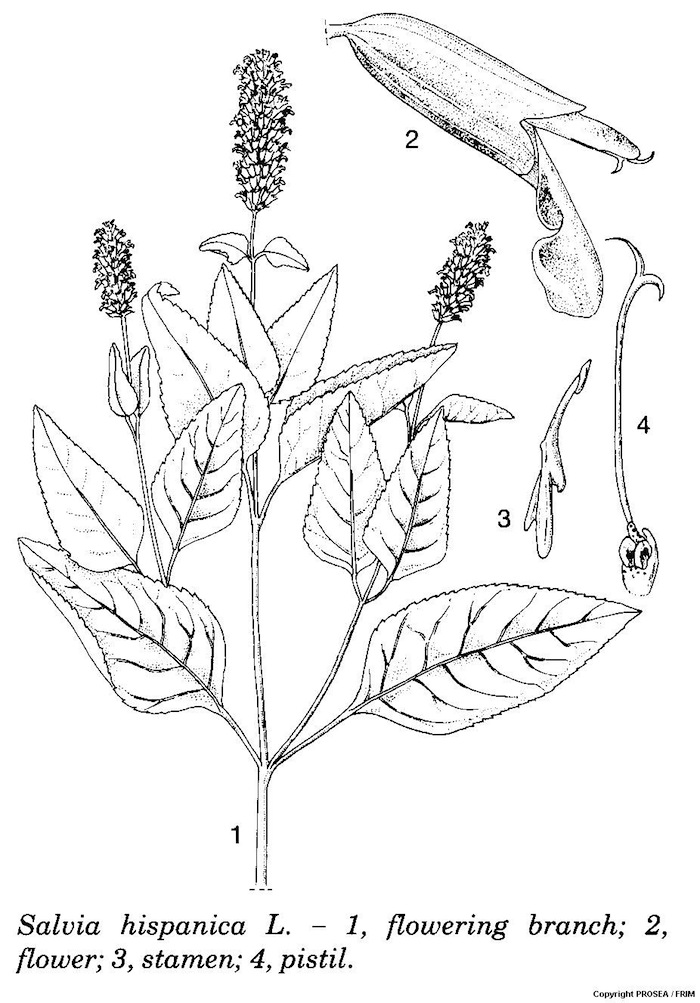Salvia hispanica L.
Family
Labiatae
Synonyms
Kiosmina hispanica (L.) Rafin., Salvia chia Sesse & Moc., Salvia schiedeana Stapf.
Vernacular Names
|
English |
Chia. |
|
Indonesia |
Cuwing, salasi huma (Sundanese). |
|
French |
Chia. |
Geographical Distributions
Salvia hispanica originates from southern Mexico and northern Guatemala. Its earliest cultivation and utilization is by the Aztecs in Central America. It was introduced and naturalised in the West Indies, Spain and West Java. It is grown commercially in central Mexico, Guatemala, United States (southern California, south-eastern Texas), north-western Argentina and occasionally in West Java, Peninsular Malaysia and Singapore.
Description
Salvia hispanica is an erect or ascending herb that can grow up to 0.5-1 m tall or more. The stem and branches are quadrangular, villous and hispid.
The leaves are arranged opposite and thin. The petiole is 1-6 cm long and slender. The blade is oblong-lance-shaped to ovate, measuring 3-8 cm x 1-4.5 cm, obtuse and abruptly attenuates at base, with entire margin at the base and serrate or serrulate elsewhere, and acute or acuminate at apex. Both surfaces are pubescent.
The inflorescence consists of verticillasters of 6-10 zygomorphic flowers. These are congested in a dense, terminal false spike measuring 5-25 cm x 1.5 cm. The internodes are 2-5 mm long. The bracts are ovate-acuminate, measure 6-8 mm long and persistent. The sepal is tubular but 2-lipped, slightly inflated below, measures 6-8 mm long, 8-11 mm in fruit and densely hairy. The upper lip is strongly keeled and sharply pointed while the lower lip is 2-toothed. The petal is tubular, 2-lipped, blue or purplish-blue. The lips are shortly exposed with tube 4.5-5.5 mm long. The upper lip is 3 mm long and rounded and sericeous outside while the lower lip is 3-lobed. It is 3.5-5 mm long. There are 4 stamens which are didynamous, hardly exposed, and with lower pair fertile and lower connective branch swollen. The disk is prominent. The ovary is superior with 2-branched style. The upper branch is long and slender. It is 2.5 mm long and pointed while the lower one is short and club-shaped. The main style articulates above the base.
The fruit consists of 4 schizocarpous nutlets where each one is ellipsoid, 1.8 mm long and mottled with black and grey.
Ecology / Cultivation
In its natural area, Salvia hispanica grows in moist or dry thickets, in open, often dry rocky slopes, sometimes on sandbars along streams and often as a weed, at altitudes 1150-2500 m. In West Java, it can be found in open areas, road sides, fallow or weedy agricultural land and low brushwoods at altitudes of 900-1700 m. In north-western Argentina, it is grown at elevations of 300-1350 m, with maximum temperature of about 30°C and minimum temperature of 12.5°C. Rainfall in this region varies between 100-1000 mm per year. This is a species of the semi-arid areas.
Line Drawing / Photograph
References
-
Plant Resources of South-East Asia No.14: Vegetable oils and fats.



